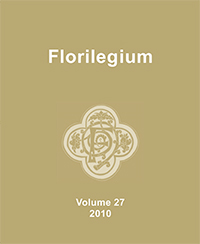The Old Saxon Heliand: Memoria as Cultural Transfer
Abstract
In the Old Saxon Heliand, one of the great poetic Bible adaptations of the ninth century, the unknown author tells the story of Christ's life for a monastic audience, availing himself of three aspects of memoria, the ancient art of memory. On the rhetorical level, the text is arranged in speeches and dialogues and uses stylistic elements like alliteration and variation, which aid individual memory. On the historical level of memoria, this early vernacular work ties in with the Carolingian renovatio, as part of an effort to overcome the past traumas of Saxon history through communal prayer in the Old Saxon language. This is achieved on the metaphysical level of memoria, which unites the memory of the past and Christian remembrance that establishes community.Downloads
Published
2010-05-01
How to Cite
Mierke, G. (2010). The Old Saxon Heliand: Memoria as Cultural Transfer. Florilegium, 27, 91–120. Retrieved from https://journals.lib.unb.ca/index.php/flor/article/view/19182
Issue
Section
Articles



